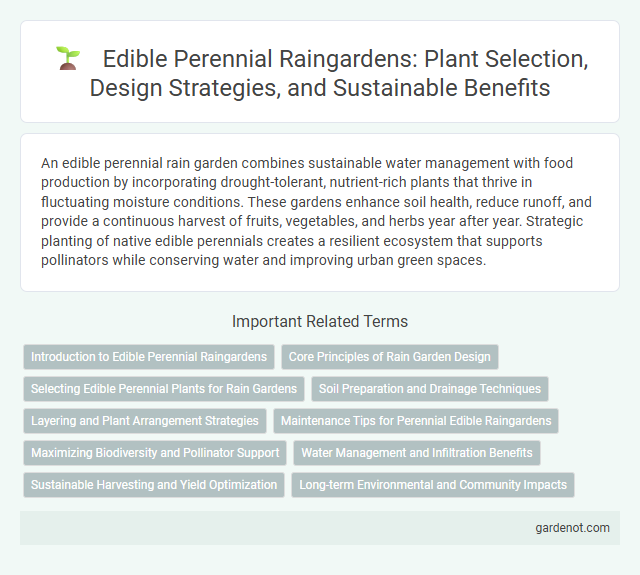An edible perennial rain garden combines sustainable water management with food production by incorporating drought-tolerant, nutrient-rich plants that thrive in fluctuating moisture conditions. These gardens enhance soil health, reduce runoff, and provide a continuous harvest of fruits, vegetables, and herbs year after year. Strategic planting of native edible perennials creates a resilient ecosystem that supports pollinators while conserving water and improving urban green spaces.
Introduction to Edible Perennial Raingardens
Edible perennial raingardens combine sustainable water management with productive landscaping by utilizing deep-rooted, edible plants that thrive in seasonal wet conditions. These gardens enhance soil infiltration, reduce runoff, and provide a continuous supply of nutritious food such as berries, herbs, and vegetables adapted to local climates. Integrating perennials like asparagus, sorrel, and elderberry maximizes ecosystem services while promoting biodiversity and resilience in urban and suburban settings.
Core Principles of Rain Garden Design
Edible perennial rain gardens integrate sustainable water management with food production by utilizing native, drought-tolerant plants that thrive in both wet and dry conditions. Key design principles emphasize soil permeability, proper slope for water infiltration, and strategic plant selection to maximize nutrient uptake and prevent runoff. Incorporating deep-rooted perennials enhances groundwater recharge while providing a resilient, low-maintenance edible landscape.
Selecting Edible Perennial Plants for Rain Gardens
Selecting edible perennial plants for rain gardens involves choosing species that tolerate both wet and dry conditions, enhancing garden resilience and productivity. Ideal plants include hardy varieties like daylilies, asparagus, rhubarb, and chives, which absorb excess water and provide continuous harvests. Incorporating native edible perennials such as serviceberries and elderberries supports local ecosystems while improving rainwater management.
Soil Preparation and Drainage Techniques
Soil preparation for an edible perennial rain garden involves deeply loosening the soil to enhance aeration and incorporating organic matter like compost to boost nutrient retention and moisture-holding capacity. Proper drainage techniques include creating a slight depression or swale to direct runoff water into the garden, ensuring slow infiltration without waterlogging plant roots. Installing layers of gravel or sand beneath the planting area can improve drainage while maintaining sufficient moisture for perennial edibles to thrive.
Layering and Plant Arrangement Strategies
Edible perennial rain gardens utilize strategic layering and plant arrangement to maximize water absorption and nutrient retention while promoting biodiversity. Deep-rooted dynamic accumulators like comfrey support soil health at lower layers, while mid-layer herbs such as chives and perennial vegetables like kale optimize space and provide continuous harvests. Tall plants, including elderberry and hazelnut, create canopy cover that reduces evaporation and protects understory crops from extreme weather.
Maintenance Tips for Perennial Edible Raingardens
Perennial edible raingardens require consistent monitoring to ensure soil remains well-drained and nutrient-rich, promoting healthy plant growth and effective water absorption. Regular pruning and harvesting prevent overcrowding, reduce pest infestations, and encourage productive yields of fruits, herbs, and vegetables. Mulching helps retain moisture and suppress weeds, while seasonal soil testing guides organic fertilization tailored to specific edible plant needs.
Maximizing Biodiversity and Pollinator Support
Edible perennial rain gardens enhance biodiversity by integrating diverse fruiting plants and flowering perennials that attract and sustain pollinators such as bees, butterflies, and hummingbirds. These gardens optimize ecosystem services by providing continuous blooms and food sources, promoting native pollinator populations and improving soil health through deep-rooted plants. Incorporating species like elderberry, daylilies, and coneflowers creates a resilient, sustainable habitat that supports both wildlife and human nutrition.
Water Management and Infiltration Benefits
Edible perennial rain gardens enhance water management by capturing and filtering stormwater runoff, reducing surface runoff and minimizing erosion. Their deep-rooted plants increase soil infiltration, promoting groundwater recharge and improving soil structure. This sustainable landscaping approach helps mitigate flooding while providing a productive source of food year-round.
Sustainable Harvesting and Yield Optimization
Edible perennial rain gardens enhance sustainable harvesting by integrating deep-rooted plants that improve soil health and water retention, resulting in consistent, nutrient-rich yields over time. Optimizing plant selection based on local climate and soil conditions maximizes productivity while minimizing maintenance and resource input. Implementing rotational harvesting and companion planting fosters biodiversity and resilience, ensuring long-term garden sustainability and food security.
Long-term Environmental and Community Impacts
Edible perennial rain gardens enhance urban sustainability by promoting biodiversity through native plants that provide both food and habitat for pollinators. Over time, these gardens improve soil health and water quality by filtering runoff and reducing erosion, contributing to long-term ecological balance. Community engagement grows as residents participate in food production and environmental stewardship, fostering stronger local connections and resilient green spaces.
Edible perennial raingarden Infographic

 gardenot.com
gardenot.com